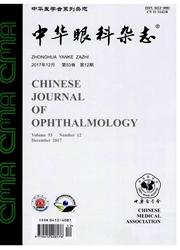

 中文摘要:
中文摘要:
目的 应用猪板层角膜做载体将人骨髓间充质干细胞(human bone marrow mesenchymal stem cells,hMSC)跨胚层诱导为上皮样细胞,甚至角膜上皮样细胞,初步探讨hMSC作为构建组织工程角膜种子细胞的可行性.方法 实验研究.用密度梯度离心培养技术结合贴壁培养法分离纯化hMSC并传代,对体外培养的hMSC进行免疫表型鉴定.将传代后的hMSC接种于去上皮的猪角膜基质片前弹力层表面培养诱导分化,免疫荧光检测角膜上皮细胞标志物角蛋白12(CK12)以及角膜缘干细胞标记物ABCG2和CK19的表达.运用体外培养的方法使种植在前弹力层表面的细胞复层化.待细胞融合形成单层后,置入插入式培养皿中进行气液界面培养.培养4周后进行HE染色及免疫组织化学检测,光镜下观察其复层情况.结果 获得的hMSC可以在体外培养扩增,表现出很强的增殖潜能.流式细胞仪示:培养的hMSC CD45阳性率为0.06%,CD34为0.41%,CD44为86.43%,CD29为85.72%,CD105为90.72%.诱导4周后部分细胞表达CK12和CK19,不表达ABCG2.运用气液界面培养法进行体外复层的结果显示可以形成1~2层的上皮样细胞,并很可能为角膜上皮样细胞.结论 在本实验的诱导条件下,hMSC可以分化为上皮样细胞,并很可能为角膜上皮样细胞,hMSC有可能作为组织工程技术角膜上皮重建的种子细胞的选择.
 英文摘要:
英文摘要:
Objective To investigate the differentiation potential of human bone marrow mesenchymal stem cells (hMSC) inducing into epithelial-like cells, even comeal epithelial-like cells, and to discuss the plasticity that make hMSC the seed cells used in comeal tissue engineering. Methods hMSC were isolated and purified by density gradient centrifugation combined with an attachment culture method and passaged in vitro. hMSC were identified by flow cytometry. The passaged hMSC were planted on fresh pig comeal Bowman's membrane. The expression of CK12, ABCG2 and CK19 in hMSC was identified by immunofluorescence staining. We used in vitro method to obtain a multilayer culture of hMSC. When hMSC formed a monolayer, the cells were inserted to Millicell culture and grew into multilauers by using the airlifting cultivation methodology. Four weeks later, after fixed and dehydrated, the hMSC were observed under the light microscope after hemotoxylin and eosin (HE) and immunohistochemistry staining. Results hMSC could be cultured, expanded in vitro, and showed great potential of proliferation. The result of flow cytometry showed that the positive staining percentage was 0.06% for CD45, 0.41% for CD34, 86.43% for CD44, 85.72% for CD29 and 90.72% for CD105. This indicated that hMSC expressed CD44, CD29, CD105 but not CD45 and CD34. After four weeks induction, part of hMSC expressed CK12 and CK19 but not ABCC2. In the in vitro stratification, HE and immunohistochemical staining showed that there were one or two layers epithelial-like cells, even corneal epithelial-like cells after using the air-lifting cultivation. Conclusions This study suggests that hMSC have the potential to differentiate into epithelial cells, even corneal epithelial cells. hMSC could be the option of cells used to reconstruct the comeal epithelium by tissue engineering technology.
 同期刊论文项目
同期刊论文项目
 同项目期刊论文
同项目期刊论文
 期刊信息
期刊信息
